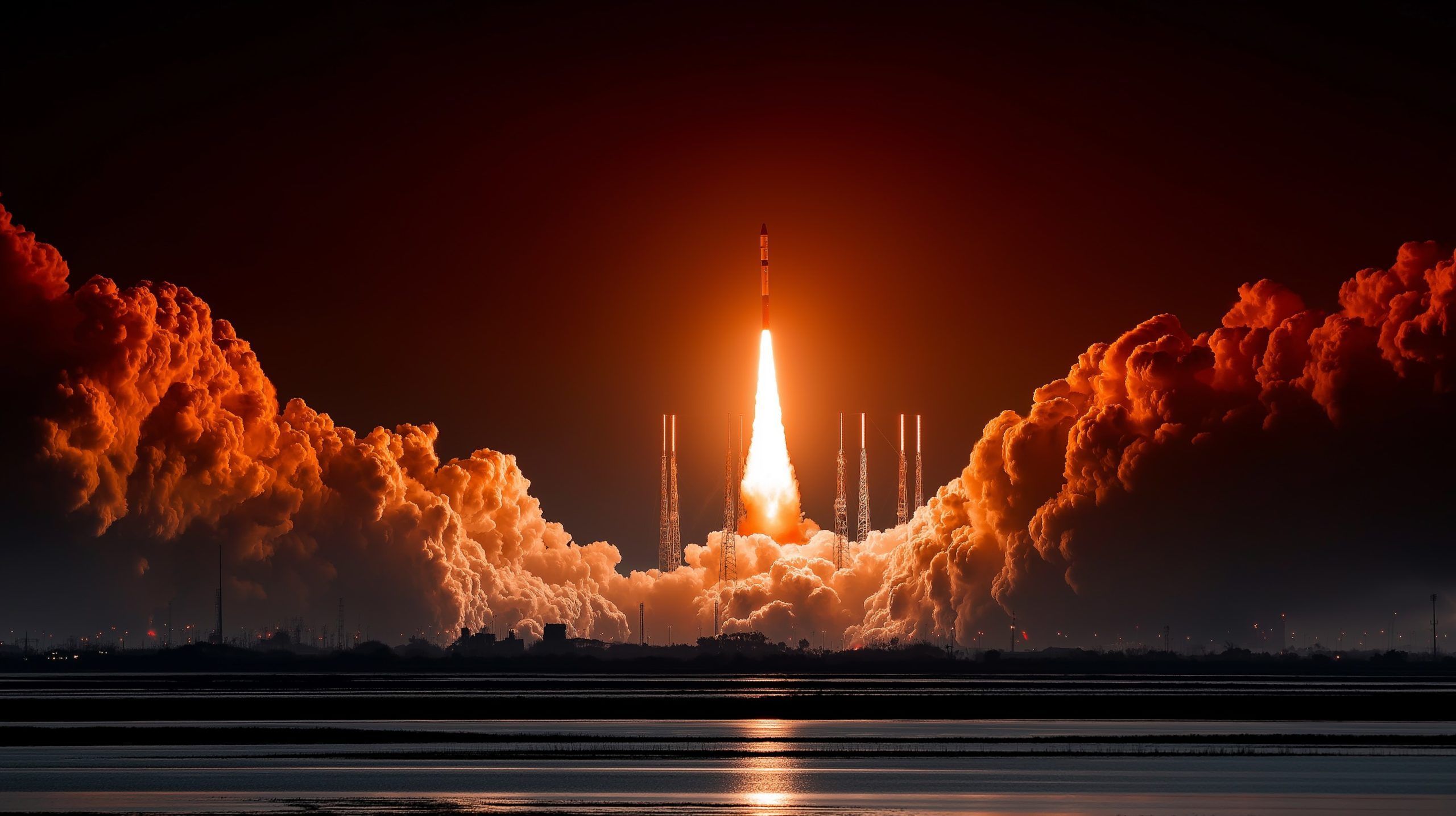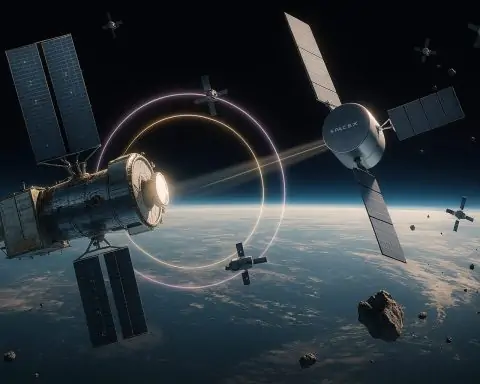- On September 19, 1988, Ofek-1 became Israel’s first indigenous satellite, making Israel the eighth nation to orbit its own spacecraft.
- The Israel Space Agency (ISA) was established in 1983 under physicist Yuval Ne’eman to oversee Israel’s civilian space activities.
- The Shavit launch vehicle is a 20-meter-tall, three-stage solid-fuel rocket that can loft about 380 kg to a low Earth orbit when launching westward from Palmachim.
- The VENμS environmental satellite, launched in 2017 and operated through 2023, is a ~265 kg microsatellite built by Israel Aerospace Industries with France’s CNES to monitor vegetation and environmental parameters.
- AMOS-1, Israel’s first commercial telecom satellite, was launched in 1996 and operated by Spacecom.
- Ofek-13, launched in March 2023, is an advanced radar observation satellite and marked the 10th successful Israeli orbital launch out of 12 attempts since 1988.
- Beresheet, SpaceIL/IAI’s privately funded lunar lander, launched on SpaceX’s Falcon 9 in February 2019 and crash-landed on the Moon on April 11, 2019 after a ~US$100 million mission.
- ULTRASAT, a space ultraviolet telescope of about 100–160 kg, is planned for launch around 2026 in geostationary orbit, with NASA signed on to launch and participate in the science.
- Dror-1, contracted by IAI in January 2020 as a national communications satellite, is planned to launch around 2025 for a roughly 15-year mission.
- Israel joined the Artemis Accords in 2022, and the AstroRad radiation vest was tested on NASA’s Artemis-1 mission.
Introduction
Israel’s space program may be modest in scale, but it has achieved outsized capabilities. In 1988, Israel became the world’s eighth nation to launch its own satellite into orbit [1], and today it remains the smallest country to develop indigenous launch vehicles and an operational space agency [2]. What began as a strategic effort to secure independent reconnaissance from space during the 1980s has grown into a multifaceted enterprise spanning civilian communications, scientific research, and commercial services. Leveraging its high-tech prowess, the nation has focused on “miniaturizing the technology” of satellites and innovating cost-effective solutions [3]. Israel’s ambitions are to punch above its weight – positioning itself among the world’s leading spacefaring nations through innovation, niche expertise, and international partnerships [4] [5]. In the process, Israel has transformed its early security-driven space program into a dynamic sector blending government initiatives with the country’s famed startup ingenuity.
Israel Space Agency (ISA)
Established in 1983 by government decision, the Israel Space Agency (ISA) is the state body that oversees and coordinates Israel’s civilian space activities [6] [7]. It operates under the Ministry of Innovation, Science and Technology (formerly Science and Technology) and was founded under the leadership of physicist Yuval Ne’eman to advance Israel’s nascent space program [8]. The ISA’s mandate encompasses scientific research, industrial development, and international cooperation in space. Despite its broad mission, ISA runs on a lean budget – approximately ₪50 million annually (about $15 million in 2019) [9] – making it one of the smaller national space agencies in resource terms. This constraint has led Israel to prioritize “unique and innovative technologies” with real economic potential and to collaborate extensively abroad [10] [11].
ISA’s strategic goals include developing home-grown satellite systems for research and Earth observation, supporting R&D in academia and industry, and investing in space-related startup companies [12] [13]. A key emphasis is on leveraging Israel’s relative advantages – such as its expertise in miniaturized satellites and communications – to create world-class niche capabilities [14]. The agency explicitly seeks to “expand Israel’s relative advantage in the field and place it among the world’s leading countries in space exploration and exploitation” [15]. Education and outreach are also central to ISA’s mission: programs to inspire youth and cultivate future scientists are funded to ensure a lasting human capital pipeline in space science [16].
International partnerships are a cornerstone of the ISA’s approach. Israel maintains cooperative agreements with major space agencies including NASA (United States), ESA (Europe), DLR (Germany), ASI (Italy), CNES (France), and others [17]. These alliances allow Israel to participate in global projects and share costs and expertise. For example, ISA joined the U.S.-led Artemis Accords in 2022, pledging cooperation in the return to the Moon and beyond [18]. (Israel contributed a novel Israeli-made radiation protective vest for NASA’s Artemis-1 Moon mission, underscoring its intent to be a valuable partner [19].) The ISA has also forged new regional partnerships; notably, in 2021 Israel and the United Arab Emirates agreed to collaborate on Israel’s upcoming “Beresheet-2” lunar mission, slated for mid-decade [20]. Through such partnerships – as well as through supporting domestic endeavors like the SpaceIL Beresheet lunar lander – the Israel Space Agency functions as the hub connecting government, academia, and industry in pursuit of the nation’s space ambitions.
Satellite Programs
Israel’s satellite programs span civilian, military, scientific, and academic domains. The country’s emphasis on small, high-performance satellites is a unifying theme across these programs, reflecting both necessity and ingenuity. Below is an overview of the key satellite categories:
Civilian and Commercial Satellites
Israel’s civilian space efforts are led by communications and Earth-observation satellites that serve commercial and national needs. The flagship AMOS series of geostationary communications satellites (AMOS stands for “Affordable Modular Optimized Satellite”) has provided Israel with independent satellite broadcasting and telecom services since the 1990s. AMOS-1, launched in 1996, was Israel’s first commercial telecom satellite, and subsequent AMOS spacecraft have delivered direct-to-home television, broadband internet, and data links across Europe, the Middle East, Africa and Asia [21]. Operated by the Israeli company Spacecom, the AMOS fleet has been steadily expanded and upgraded – for example, AMOS-17 (launched in 2019) is a state-of-the-art high-throughput satellite enhancing coverage over Africa [22] [23]. Most AMOS satellites were built locally by Israel Aerospace Industries (IAI), demonstrating Israel’s domestic manufacturing capabilities, though in some cases Israel has procured satellites internationally (AMOS-5 was built in Russia and AMOS-17 by Boeing in the US) [24]. The AMOS program underpins not just commercial broadcasting but also secure communications for the government and military when needed [25], illustrating the dual-use nature of much of Israel’s space infrastructure.
In Earth observation, Israel has pursued cooperative civilian satellite missions to apply space-based imaging for environmental and scientific purposes. A notable example is VENμS (Vegetation and Environment Monitoring on a New Satellite), a micro-satellite launched in August 2017 as a joint project between ISA and France’s CNES [26]. VENμS carries a special camera to monitor vegetation growth, desertification, water quality and other ecological parameters at high frequency, supporting agricultural and environmental research. The satellite – about the size of a mini-fridge (~265 kg) – was built largely in Israel (by IAI) with a French optical payload, and operated in a sun-synchronous orbit until 2023 [27]. Another international Earth-observation effort in development is the SHALOM mission (Spaceborne Hyperspectral Applicative Land and Ocean Mission), a jointly funded project with the Italian Space Agency to launch a hyperspectral imaging satellite for detailed environmental monitoring [28]. Through such collaborations, Israel gains access to valuable data for civilian use (agriculture, climate, urban planning) while sharing development costs and scientific output with partners.
Military Reconnaissance Satellites (Ofek Series)
At the core of Israel’s defense space capabilities is the Ofek (or Ofeq, meaning “Horizon”) series of reconnaissance satellites. These military satellites were born from Israel’s strategic need to obtain real-time intelligence from space, especially when aerial reconnaissance flights over hostile neighbors became untenable in the late 1970s [29]. The Ofek program achieved a historic milestone on September 19, 1988, when Ofek-1 was launched – making Israel the 8th nation to launch an indigenous satellite into orbit [30]. That inaugural launch (and all subsequent Ofek launches) used Israel’s Shavit rocket, flying westward over the Mediterranean.
From those beginnings, the Ofek series has evolved into a line of small but sophisticated spy satellites providing Israel with independent imaging intelligence. Early satellites (Ofek-1 and 2) were experimental, but with Ofek-3 in 1995 Israel deployed its first operational reconnaissance payload [31]. Since then, successive Ofeks have delivered ever-improving surveillance capabilities – either high-resolution electro-optical cameras or synthetic aperture radar (SAR) sensors – despite their compact size (~300 kg class). Because of Israel’s geographic constraint (launches must avoid flying over Middle Eastern neighbors), Ofek satellites are inserted into retrograde orbits (~143° inclination, opposite Earth’s rotation) [32]. This unique launch approach reduces the Shavit rocket’s lift capacity, so Israel compensated by excelling in miniaturized satellite technology that packs advanced optics and electronics into lighter satellites [33]. Modern Ofek satellites achieve ground imaging resolutions on the order of 0.5 meters or better with electro-optical cameras, rivaling larger spy satellites [34]. Others in the series carry all-weather radar imagers to see through clouds and at night.
Notable members of the constellation include Ofek-5 (2002) and Ofek-7 (2007), which provided Israel’s first high-quality reconnaissance images, and Ofek-9 (2010) and Ofek-11 (2016) which introduced next-generation imaging technology (Ofek-11, though it experienced technical glitches, eventually delivered imagery) [35]. Ofek-10 (launched 2014) was a second-generation radar spy satellite (sometimes called TecSAR-2) enabling improved SAR imagery for military intelligence [36]. During the height of the COVID-19 pandemic in July 2020, Israel successfully orbited Ofek-16, an electro-optical spy satellite carrying the most advanced camera Israel had put in space to date [37] [38]. That “Jupiter” telescopic camera, developed by Elbit Systems’ Elop division, can distinguish objects under 0.5 m in size from orbit [39] – a testament to Israel’s world-class electro-optics. Most recently, in March 2023, Israel launched Ofek-13, described as an “advanced radar observation satellite” with improved SAR capabilities [40]. Ofek-13’s successful deployment marked the 10th successful Israeli orbital launch out of 12 attempts since 1988 [41], and it further bolsters Israel’s ability to continuously monitor regional developments (such as Iran’s nuclear sites or hostile military movements) from space.
All Ofek satellites to date (except one) have been launched on Israel’s own Shavit rockets from Palmachim Airbase. A one-time exception was TecSAR-1 – essentially Ofek-8 – which Israel launched via an Indian PSLV rocket in 2008 to quickly deploy a SAR satellite at a time when domestic launch slots were limited [42]. The Ministry of Defense manages the Ofek program with Israel Aerospace Industries as the prime contractor (IAI’s Systems, Missiles & Space Group builds the satellite bus and integration). Image processing and analysis are handled by Unit 9900 of the IDF’s Intelligence Directorate, giving Israel an independent, realtime spy satellite capability that only a handful of nations possess. This “eye in the sky” is considered critical for Israel’s security – allowing clandestine monitoring of distant adversaries and reducing reliance on allies for satellite imagery [43].
Scientific and Exploratory Missions
Israel’s drive to expand its space horizons is also evident in a number of scientific, research, and exploratory missions. Perhaps the most famous is Beresheet, the lunar lander created by Israeli nonprofit SpaceIL in partnership with IAI. In February 2019, Beresheet was launched as a secondary payload on a SpaceX Falcon 9, and over the next two months it executed a series of maneuvers to reach the Moon’s orbit [44] [45]. On April 11, 2019, Israel stood on the brink of history as Beresheet attempted to land on the lunar surface – which would have made Israel only the fourth country to achieve a Moon landing. Ultimately, a last-minute engine failure caused the spacecraft to crash into the Moon [46]. Despite the crash, the mission was lauded as a remarkable achievement: Beresheet transmitted images from just a few hundred feet above the Moon and demonstrated that a small nation’s privately funded probe (~$100M budget) could come tantalizingly close to a lunar landing [47] [48]. The Beresheet saga invigorated public interest in space, and a successor mission Beresheet-2 is now in development with international collaboration. Planned to launch in 2025, Beresheet-2 will carry two landers and an orbiter to attempt a lunar landing again, including scientific experiments (such as a mini lunar greenhouse) involving partners from Israel and the UAE [49] [50]. NASA has also agreed to support Beresheet-2 with deep space communication and navigation services, reflecting the mission’s global significance.
Within Earth orbit, Israel has executed several scientific satellite missions. Apart from VENμS (described earlier), a forthcoming mission is ULTRASAT, a space ultraviolet telescope planned by the Weizmann Institute and ISA. ULTRASAT will be a small satellite (roughly 100–160 kg) in geostationary orbit, designed to detect ultraviolet emissions from transient astronomical events (like neutron star mergers), with a target launch around 2026 – NASA has signed on to launch it and participate in the science. Earlier Israeli scientific satellites include the TechSat Gurwin-II (also known as Gurwin-TechSat) launched in 1998 – an innovative 48 kg microsatellite built by Technion (Israel’s Institute of Technology) carrying experiments in ionospheric research and radio communications. Israel also partnered with international agencies on unique science missions: for example, in 2005, Israel was part of the Dutch-led Sloshsat-FLEVO mission, a 129 kg microsatellite that studied fluid dynamics in microgravity (helping to design better fuel tanks). These projects, though smaller than flagship missions of superpowers, have allowed Israeli scientists to contribute to space science and gain experience in satellite design on a limited budget.
Israel’s scientific contributions extend to human spaceflight and beyond. In the 1990s and early 2000s, Israeli researchers flew a series of experiments on NASA Space Shuttle missions (studying topics from insect physiology to dust storms). Israel’s first astronaut, Ilan Ramon, flew aboard the Space Shuttle Columbia in 2003 and conducted the MEIDEX atmospheric experiment, tragically losing his life with the rest of the STS-107 crew when Columbia broke apart on re-entry. More recently, in 2022, Israeli entrepreneur Eytan Stibbe flew to the International Space Station as a private astronaut, carrying out a set of Israeli microgravity experiments during the “Rakia” mission. And in 2022, as noted, Israel’s AstroRad radiation vest – developed by Tel Aviv-based StemRad in collaboration with Lockheed Martin – was tested on NASA’s Artemis 1 Orion capsule, to evaluate how to protect astronauts from deep-space radiation [51]. This mix of science and innovation showcases Israel’s ability to carve out roles in international endeavors by offering specialized technologies and scientific expertise.
Nano- and Microsatellite Initiatives
One of Israel’s hallmarks in space is its focus on nano- and microsatellites, which aligns with the country’s excellence in miniaturized high-tech systems. Dozens of Israeli small satellites – many developed by universities or even high schools – have been launched, demonstrating new technologies and providing hands-on training to the next generation of engineers. The Duchifat series is a prime example. Duchifat-1 (Hebrew for “Hoopoe,” Israel’s national bird) was the country’s first pico-satellite, built by Israeli high school students and launched in June 2014 [52]. This tiny 1U CubeSat (10×10×10 cm, ~1 kg) was designed for amateur radio communication and to engage youth in space science; it remains in orbit years later. Following that, high schoolers from the Herzliya Science Center built Duchifat-2, a 2U CubeSat (~1.8 kg) that was launched to the International Space Station in April 2017 and later deployed into orbit [53] [54]. Duchifat-2 was part of a European QB50 thermosphere research project and carried a sensor to study atmospheric density, making it the only high-school-built satellite in an international scientific constellation [55]. In 2019, a successor Duchifat-3 (3U CubeSat) was launched on a PSLV rocket, carrying an imaging payload for ecological research in coordination with Herzliya and Sha’ar HaNegev students. These student satellite projects – supported by ISA and academia – not only collect valuable data but also serve an educational mission “bringing space closer to youth and paving the way for tomorrow’s generation” [56] [57].
University-led small satellite projects have likewise flourished. In 2017, Ben Gurion University and ISA launched BGUSAT, a 3U CubeSat with an innovative multispectral camera to image Earth for environmental monitoring. The Technion (Israel’s Institute of Technology) has been especially active: in March 2021, Technion’s Asher Space Research Institute launched Adelis-SAMSON, a groundbreaking mission consisting of three nano-satellites (each 6U, ~8 kg) flying in formation to track signals on Earth’s surface for search-and-rescue and geo-location experiments [58] [59]. The SAMSON satellites demonstrated autonomous flight algorithms and inter-satellite links, showcasing how multiple tiny satellites could cooperate to perform tasks of a larger satellite. Tel Aviv University joined the fray in 2021 with TAU-SAT1, its first nano-satellite (a 0.25U “CubeSat” launched from the ISS) to measure cosmic radiation in low orbit. Even small colleges and international collaborations are involved – for instance, Ariel University’s students built the SATLLA-1 nanosatellite, and Israel’s first-ever space greenhouse experiment is slated to fly on Beresheet-2’s orbiter in the coming years [60].
To institutionalize this trend, ISA and the Ministry of Science initiated the Tevel program around 2018, which has provided kits and training for multiple high schools (Jewish and Arab) to build their own CubeSats. In early 2022, the program culminated in 8 nano-satellites constructed by different youth teams being launched together as a single constellation [61]. Each student-built satellite has a unique experiment (from imaging to GPS tracking), and together they form a network that Israeli students can communicate with and operate – a remarkable learning platform. These efforts in the nano-satellite realm reflect a national strategy: Israel recognizes that “space engineering and research at costs affordable for academia” is a force multiplier [62]. By excelling in small satellites, Israel not only mitigates its launch limitations but also creates exportable technologies (in mini sensors, micro propulsion, etc.) and fosters a highly skilled workforce. Indeed, Israel is regarded as a world leader in miniaturized satellite technology, building “small, light satellites with high-resolution sensing and communication capabilities” that perform missions once requiring far larger craft [63]. This small-satellite niche is both a practical necessity and a competitive advantage for Israel’s space industry.
Table 1: Major Israeli Satellites (selection of representative missions)
| Satellite / Mission | Launch Year | Purpose | Operator | Status |
|---|---|---|---|---|
| Ofek-1 (Horizon 1) | 1988 | Technology demonstration; first Israeli satellite launch [64] | Ministry of Defense (Israel) | Deorbited (1988–1989) |
| Ofek-5 | 2002 | Optical reconnaissance (first high-resolution IMINT) | Ministry of Defense | Retired (mission ended) |
| Ofek-10 | 2014 | “TecSAR-2” radar reconnaissance (all-weather spy satellite) [65] | Ministry of Defense | Operational (as of 2021) |
| Ofek-16 | 2020 | Electro-optical reconnaissance (advanced high-res camera) [66] [67] | Ministry of Defense | Active (imaging intelligence) |
| Ofek-13 | 2023 | Synthetic Aperture Radar reconnaissance (advanced SAR capabilites) [68] | Ministry of Defense | Active (in commissioning) |
| AMOS-1 | 1996 | Communications (C-band Ku-band satellite for TV, telecom) | Spacecom (commercial) | Retired (replaced by newer AMOS) |
| AMOS-6 | 2016 | Communications (broadband & connectivity satellite) | Spacecom | Lost (destroyed in launch pad accident) [69] [70] |
| AMOS-17 | 2019 | Communications (high-throughput satellite for Africa/Mideast) | Spacecom | Active (at 17°E orbital slot) |
| EROS-A | 2000 | Earth Resource Observation (commercial imaging, ~1.8 m resolution) | ImageSat International | Retired (reentered ~2006) [71] |
| EROS-B | 2006 | Earth observation (high-resolution imaging, ~0.7 m) | ImageSat International | Active (extended mission) |
| EROS-C3 | 2022 | Earth observation (very high-res imaging ~0.3 m; part of new constellation) [72] | ImageSat International | Active (launched via SpaceX) |
| TecSAR-1 (Ofek-8) | 2008 | Reconnaissance (first Israeli synthetic-aperture radar satellite) | Ministry of Defense | Active (SAR imaging) |
| VENµS | 2017 | Environmental monitoring (vegetation, climate) [73] | ISA & CNES (France) | Completed (2017–2023 mission) |
| Beresheet (SpaceIL) | 2019 | Lunar lander (private Moon mission; proved technology) | SpaceIL / IAI | Failed at landing (crash landed) [74] |
| Beresheet-2 (planned) | ~2025 | Lunar lander & orbiter (2 landers for Moon’s far side) | SpaceIL / ISA (with UAE, etc) | In development (launch planned 2024–25) [75] |
| Adelis-SAMSON (3 × 6U) | 2021 | Three nano-sat formation flight (signal geolocation experiment) [76] | Technion (Academia) | Active (technology demo) |
| Duchifat-1 (1U) | 2014 | Educational nanosatellite (student-built, APRS comm) | Herzliya Science Center (HS) | Active (in orbit) [77] |
| Duchifat-2 (2U) | 2017 | Thermospheric research (student-built, part of QB50 project) [78] [79] | Herzliya Science Center (HS) | Active (deployed from ISS) |
| Duchifat-3 (3U) | 2019 | Earth imaging experiment (student-built, ecological studies) | Herzliya & Sha’ar HaNegev (HS) | Active (in orbit) |
Sources: Israel Ministry of Defense/ISA releases [80] [81]; Spacecom/IAI data [82] [83]; ImageSat International reports [84] [85]; ISA/CNES on VENµS [86]; SpaceIL & media on Beresheet [87]; academic publications on SAMSON [88]; Israel21c on Duchifat program [89] [90].
(Table Note: “HS” = High School project; many military satellite details are classified, so only open-source information is shown.)
Satellite Services and Industry
Israel’s Space Industry Ecosystem: Over 60 Israeli companies (ranging from large defense contractors to NewSpace startups) are active in the space sector [91]. The industry supplies satellites, launch systems, ground stations, and a variety of services. Below is a summary of the major players and the services they provide:
| Company | Specialties & Services | Notable Contributions |
|---|---|---|
| Israel Aerospace Industries (IAI) – “Space House” [92] | Satellite design & manufacturing (communication, observation, scientific); spacecraft integration; launch vehicle development (Shavit rocket); space avionics and ground control systems. | Built the Ofek spy satellites and AMOS comsats (prime contractor) [93]. Developed and produces the Shavit orbital launch vehicle [94] [95]. Exported satellites (e.g. built Italy’s OPTSAT-3000) and developing new mini-communication satellite platforms [96] [97]. |
| ImageSat International (ISI) | Commercial Earth-observation services; satellite operation and imagery analysis for defense and intelligence clients. Markets high-resolution imaging from its proprietary EROS satellite constellation. | Operates the EROS-A/B/C series of imaging satellites (built by IAI) providing sub-meter imagery globally [98]. EROS-C3 (2022) offers ~30 cm resolution and is part of ISI’s planned four-satellite optical + two-satellite radar constellation by 2030 [99]. Supplies geospatial intelligence to governments (incl. Israel) and commercial customers under secure data protocols [100]. |
| Spacecom (Space Communication Ltd.) | Satellite communications operator; manages Israel’s AMOS fleet and provides transponder capacity and satellite services for TV broadcast, broadband internet, and corporate/government communications. Also invests in space-tech ventures (incubators, startups). | Owns and operates AMOS-3, 7, 17 satellites, covering EMEA regions with C/Ku/Ka-band beams [101]. Partnered with ISA to establish the “Earth & Beyond” space-tech incubator (won gov’t tender in 2020) to nurture startups in satellite and data applications [102]. Clients include broadcasters, telecom providers, and security agencies. Working on AMOS-8/Dror-1 next-gen satellite with IAI to ensure national satcom continuity. |
| Rafael Advanced Defense Systems | Space propulsion and satellite subsystems; develops rocket motors, thrusters, and innovation in smallsat platforms. Brings defense-grade technologies (e.g. guidance, hyper-spectral sensors) to space applications. | Provided the third-stage motor for the Shavit launcher (AUS-51 solid rocket motor) [103] and maneuvering thrusters for satellites (Rafael’s hydrazine thrusters are used in Ofek spy sats) [104] [105]. Developing electric propulsion (Hall-effect thrusters) for satellites and exploring micro-satellite constellations for reconnaissance and communication (leveraging dual-use tech). Contributed to Iron Beam laser-project in space and other R&D. |
Beyond these four, other important entities include Elbit Systems, which produces many satellite payloads (e.g. the high-resolution Jupiter space camera on Ofek-16 was made by Elbit’s Elop division [106]), and communication equipment firms like Gilat Satellite Networks (a leader in satellite modems and VSAT networks). A vibrant startup scene is also emerging: companies such as SpaceIL (lunar landers), Effective Space (satellite life-extension, now part of Astroscale), Space Pharma (microgravity biotech labs in CubeSats), NSLComm (novel deployable antennas for nanosatellites), and Helios (ISRU technology to produce oxygen on the Moon) are examples of Israeli NewSpace ventures.
The Israeli government, recognizing this momentum, launched initiatives to support space entrepreneurs. In 2020, the ISA and Innovation Authority set up Israel’s first space-tech incubator, “Earth & Beyond,” to provide seed funding, facilities, and mentorship to space startups [107]. This incubator (led by Spacecom with partners) and an accelerator program called Astra (run by Starburst with IAI) are fostering dozens of new ventures [108]. The goal is to double the number of space companies in Israel (from ~60 to 120+) within a few years and create a self-sustaining commercial space ecosystem [109]. Indeed, in 2022 the government announced a ₪600 million (∼$180 M) multi-year investment to galvanize the civilian space industry, aiming to quadruple the sector’s workforce (from ~2,500 to 10,000 employees) and significantly boost revenues [110] [111]. This infusion is already bearing fruit: by 2025, Israeli startups are working on everything from reusable rockets and small launchers to Earth analytics software, and local venture capital is increasingly interested in space ventures [112] [113].
In summary, Israel’s space industry is a synergistic network of defense primes, specialized service providers, and nimble startups. They collectively deliver a full spectrum of satellite services: manufacturing satellites and launchers (IAI, Rafael), operating satellite systems and data services (Spacecom, ImageSat, etc.), and developing next-generation innovations (the startup community). The ISA acts as facilitator, linking these players with academia and global partners. With strong government backing and the innate “start-up nation” culture, Israel’s space sector is transforming into a significant commercial market in its own right, even as it continues to meet national security needs [114] [115].
Launch Capabilities
An Israeli Shavit-2 rocket launching the Ofek-13 satellite in March 2023 from Palmachim Airbase (nighttime launch seen here). Israel must launch westward, over the Mediterranean, which imposes unique challenges [116].
Israel is one of a select few countries with an indigenous orbital launch capability. Its solid-fueled Shavit rocket has been the workhorse of Israel’s space launches since the late 1980s. The primary launch site is Palmachim Airbase on the Mediterranean coast south of Tel Aviv – effectively Israel’s spaceport [117]. Due to Israel’s narrow geography and the hostile nations to its east, all launches are conducted westward over the sea (into retrograde orbit) to avoid dropping stages over populated areas or neighboring territories [118]. This means Shavit goes against Earth’s rotation, incurring a significant performance penalty (losing the boost that eastward launches gain from Earth’s spin). As a result, Shavit can orbit only relatively light payloads. The current Shavit-2 vehicle (three stages, all solid propellant) can lift about 380 kg to a low Earth orbit when launching westward from Israel [119]. Coincidentally, Israel’s reconnaissance satellites are designed to weigh in the 250–300 kg class, matching this constrained lift capacity [120].
The first Shavit launch on September 19, 1988 carried Ofek-1 and instantly vaulted Israel into the club of spacefaring nations [121]. Shavit’s design is derived from Israel’s Jericho ballistic missile technology, adapted for satellite deployment. Over time it has seen iterative improvements. Early Shavit versions had two stages (with a small optional third stage), while the modern Shavit-2 uses three main solid stages and can incorporate a liquid-propellant kick motor if needed for orbit insertion [122]. The rocket stands roughly 20 m tall – a relatively small launcher – and uses Israeli-made components: the first two stage motors (ATSM-13) are produced by Elbit Systems (previously Israel Military Industries), and the third stage (AUS-51) is produced by Rafael [123]. This highlights how Israel’s defense industry supports launch vehicle production. Shavit launches are infrequent (reflecting the limited number of Ofek satellites and Israel’s cautious scheduling). Historically, Israel’s launch cadence has averaged about one every 2–3 years [124]. Notably, after two launch failures in the 1990s (in 1998 and 2004), the Shavit-2 variant was introduced with upgrades, and it has achieved a perfect success record since 2007 [125]. The most recent launches – Ofek-16 in 2020 and Ofek-13 in 2023 – both went off flawlessly, demonstrating the maturity of Shavit-2.
While Shavit gives Israel independent access to low Earth orbit, its limitations (in payload and inclination) mean Israel often relies on foreign launch providers for other missions. All of Israel’s heavy or high-altitude satellites have been launched abroad. For example, the AMOS communications satellites (which go to geostationary orbit ~36,000 km up) have used various international rockets: AMOS-1 in 1996 rode a European Ariane 4, AMOS-2 (2003) a Russian Soyuz, AMOS-3 (2008) a Ukrainian Zenit-3SL, AMOS-5 (2011) a Russian Proton, and AMOS-17 (2019) a SpaceX Falcon 9 [126]. In 2016, the ill-fated AMOS-6 was destroyed in a Falcon 9 launch pad accident in Florida [127] [128], illustrating the risks of space launch (and prompting Israel to build a replacement, AMOS-7, via an interim solution). Military and scientific satellites have also gone on foreign boosters when advantageous: the TecSAR radar satellite (Ofek-8) was launched by India’s PSLV in 2008 [129]; the French-Israeli VENμS satellite went up on an Arianespace Vega in 2017 [130]; and as discussed, the Beresheet Moon lander hitched a ride on a SpaceX Falcon 9 in 2019 [131]. Most recently in December 2022, Israel used a SpaceX Falcon 9 to launch the EROS-C3 imaging satellite from Vandenberg Space Force Base in California [132] – the satellite was successfully delivered to orbit and the Falcon’s first stage even landed back onshore, exemplifying the cost-effective opportunities in the new era of commercial launch providers.
Israel has shown flexibility in its launch strategy: using its own launcher for critical national-security payloads (where launch timing and secrecy are paramount), and international partners for everything else. Notably, Israel’s collaboration with India’s ISRO on launches (PSLV) and with SpaceX in recent years has expanded its access to space. There have even been discussions about Israel launching small satellites from sites outside Israel (to allow prograde orbits), and about possible future development of new launch vehicles or participation in multinational launch ventures – although no concrete new launcher has been announced. IAI has marketed a commercial variant of Shavit (called “LeoLink”) in the past [133], but global competition in the small launch market is intense. For now, Israel’s proven launch capability via Shavit remains a point of national pride and strategic independence. The Palmachim range, though used sparingly, ensures that Israel can put a satellite up at will if national security dictates. This combination of an indigenous launch option and reliable foreign launch access gives Israel’s space program a great deal of resilience and flexibility.
Recent Developments and Future Plans
In the past few years, Israel’s space sector has entered a new phase of expansion with significant milestones and forward-looking projects on the horizon. A number of recent developments stand out:
- Upgraded Reconnaissance Capabilities: The launch of Ofek-13 in March 2023 marked the latest advancement in Israel’s spy satellite arsenal [134]. Ofek-13’s SAR sensor is reported to be the most advanced Israel has fielded, improving the resolution and imaging throughput for Israeli intelligence. Its successful deployment also continued the string of flawless Shavit-2 launches [135]. Looking ahead, Israeli defense officials hint at even more capable satellites in development – including next-generation electro-optical platforms with sub-0.3 m resolution and persistence, and possibly a second-generation TecSAR. Each new satellite increases coverage and reduces revisit times over critical targets. There is also growing export interest: in 2020 Israel sold an older TecSAR-class satellite to the Italian military (OPSAT-3000), and in 2024 it was reported that Morocco will acquire an advanced Israeli observation satellite [136]. Such deals could finance further R&D while strengthening alliances.
- Next-Generation Communication Satellite: After some turbulence in its communications satellite program (the AMOS-6 loss in 2016 and cancellation of a planned AMOS-8 built by a foreign supplier), Israel decided to return to an indigenous comsat. In January 2020, IAI was contracted to develop “Dror-1,” a national communications satellite intended to meet Israel’s strategic needs for 15 years [137]. Dror-1 (also sometimes referred to as AMOS-8 in older plans) is envisioned as an advanced, modular satellite using mainly Israeli technology – essentially rebooting the local satellite manufacturing capabilities. IAI has unveiled concepts for smaller, “smartphone-like” communications satellites that can be reprogrammed on-orbit and use digital beam-forming [138]. Dror-1 is expected to launch around 2025 and will secure Israel’s independent satellite communications for military and civilian uses, replacing capacity from aging AMOS craft [139]. If successful, it could lead to a new line of Israeli exportable comsats as well.
- Booming “NewSpace” Industry: Israel’s government and investors have recognized the global space economy is rapidly growing (estimated ~$400 billion market) [140] and are determined to capture a bigger share. The 2022 five-year plan by ISA/MOST injected ₪600 M into the sector with explicit goals: double the number of space companies to 120+, quadruple space industry employment to 10,000, and boost academic participation [141] [142]. Already we are seeing the fruits of this plan. The Earth & Beyond incubator has funded multiple startups since 2021, and private venture capital involvement in space startups has increased (Israel’s VC firm Type5 and others launched dedicated space funds [143]). There’s also a target to increase space-related research in universities (from 120 researchers to 160+) and even raise the number of space-interested high schoolers from a few hundred to thousands [144] – a holistic approach to sector growth. By 2030, Spacecom’s Ofer Asif predicts “hundreds of NewSpace startups employing 20,000 people” in Israel [145]. Areas of particular Israeli focus include satellite miniaturization (continuing to lead in smallsat tech), deep-space technologies (like lunar payloads, as with Beresheet), ground station and data services (leveraging Israel’s software talent for satellite data analytics), and even space security and debris mitigation (Israel’s laser and robotics know-how could aid in active debris removal – an area where Israeli firms have begun patent work).
- International Collaboration and Ambitions: On the global stage, Israel is stepping up its participation. Joining the Artemis Accords in 2020–2021 signaled Israel’s intent to be part of humanity’s return to the Moon and beyond [146] [147]. In practical terms, beyond the AstroRad vest on Artemis 1, Israel’s inclusion in Artemis could lead to Israeli experiments flying on Gateway (NASA’s planned lunar space station) or Israeli tech being used in Artemis base camps. For example, Israeli startup Helios has a contract with NASA to demonstrate oxygen extraction from lunar soil, which might occur on a future Moon mission. The Beresheet-2 mission, slated for 2025, embodies this international ambition: it involves partnerships with the UAE (for payloads and possibly a joint outreach program) [148], and arrangements with NASA for communications. If Beresheet-2 succeeds in landing two probes on the far side of the Moon, Israel will cement its status as a serious player in deep space exploration. Moreover, Israel has been in talks with NASA and ESA about contributing instruments to planetary missions and joining global earth-observation programs (e.g. European Copernicus). The SHALOM hyperspectral satellite with Italy shows Israel’s willingness to co-develop expensive missions and share data for mutual benefit. In Asia, Israel continues to work with India – discussions are reportedly underway for Israel to provide mini-satellites or payloads for Indian missions, capitalizing on the goodwill from the PSLV launches. All these plans underscore that Israel’s future in space will be increasingly collaborative and international in scope.
- Space Defense and Security Initiatives: Given rising global concerns about space as a contested domain, Israel is also likely to invest in protecting its space assets. Though much is classified, Israeli defense firms are quietly researching satellite cyber defense, electronic shielding, and possibly counter-space measures (for instance, using lasers or microsatellites to inspect or secure Israel’s satellites – concepts aligned with Israel’s high-tech defense posture). In 2020 the IDF announced the creation of a Space Administration under its Air Force, to coordinate military space operations and strategy. One future plan might be a unified spy satellite constellation that blends military and commercial assets (Ofek, EROS, etc.) into a network for real-time surveillance – essentially Israel’s version of a responsive space network. Additionally, space-based early-warning (for missile launches) is an area of interest; Israel has historically relied on U.S. early-warning satellites, but plans have been floated to develop an Israeli early-warning satellite, which would be a new class of spacecraft for the country.
- Space Exploration and Science: On the scientific front, Israel’s near-term plans include launching ULTRASAT (the UV astronomy satellite) around 2026 – a mission that could yield groundbreaking data on transient cosmic events and involve a broad international science team. If ULTRASAT proves successful, Israel could position itself as a leader in “shoebox science satellites” – relatively inexpensive missions that answer specific scientific questions. Also, the Rakia mission in 2022 (with astronaut Stibbe) set a template for how Israel might conduct human-related space research. It wouldn’t be surprising if Israel seeks to fly another astronaut in the coming decade, perhaps via the U.S. or a private Axiom Space mission, to continue microgravity R&D and inspire public interest. The government has already stated that space is “no longer only for great powers… Space is now open for business”, as ISA Director Uri Oron put it [149]. This philosophy suggests Israel will pursue opportunities in emerging areas like space manufacturing (using 3D printing and Israeli materials tech in orbit), satellite servicing (building on the work of Effective Space/Astroscale Israel), and even space agriculture (like the Beresheet-2 greenhouse experiment) to ensure it stays at the cutting edge.
Overall, Israel’s trajectory in space for the coming years is one of growth and diversification: more satellites (both government and commercial) in orbit, more startups entering the field, deeper international involvement, and new applications of space technology for both security and socioeconomic benefit. If the goals set in 2022 are met, by the end of this decade Israel will have a significantly larger space economy, one that retains its “secret strength” of agility and innovation while moving more into the global spotlight.
Challenges and Opportunities
As Israel’s space enterprise advances, it faces a distinctive mix of challenges and opportunities:
- Resource Constraints vs Ambitions: Israel’s civil space budget remains relatively small – on the order of $15–20 million per year [150] – which is tiny next to NASA or ESA. This limited funding constrains the number of projects Israel can undertake at once and makes prioritization vital. However, the flip side is that Israel has learned to “do more with less,” achieving world-class results on shoestring budgets [151] [152]. The recent infusion of ₪600 M (~$180 M) over five years is a significant boost [153], but sustaining long-term investment will be a challenge amid other national priorities. Israel’s opportunity here is to continue leveraging international partnerships and private capital to multiply its capabilities – essentially doing big things with shared costs. Success in this model could make Israel a case study in cost-effective space innovation.
- Geopolitical and Security Challenges: Israel’s unique geopolitical situation both necessitates and complicates its space efforts. The need for independent spy satellites and secure communications is driven by very real security threats – making programs like Ofek and Amos strategic imperatives. Yet, regional geopolitics also means Israel cannot launch satellites eastward, limiting payload capacity and orbit choices [154]. The country has brilliantly turned this launch handicap into an advantage by specializing in miniaturized satellites, but it remains a challenge (larger payloads will always need foreign launch). Security concerns also affect international cooperation: Israel must be cautious in sharing sensitive technologies or data. Nonetheless, recent peace deals (e.g. with UAE, Bahrain) open new possibilities for regional space collaboration, and space can be a bridge for diplomacy. The Abraham Accords already yielded a joint Beresheet-2 effort [155]; similarly, Israel might work with other friendly states (like Japan or Germany) on defense-related space tech under proper safeguards. An opportunity exists for Israel to be a key player in space security on the global stage, contributing its cyber defense and missile defense expertise to help secure satellites (an increasing international concern).
- Global Competition and Market Position: The global space sector is becoming crowded, with many nations and companies launching satellites and vying for market share in areas like satellite imaging, communications, and launch services. Israel’s traditional strengths (high-quality imaging, military-grade tech) now face competition from commercial constellations (e.g. Planet, Maxar, Starlink) and other countries’ programs (e.g. UAE’s growing space activities, Turkey’s planned observation satellites, etc.). To stay relevant, Israel must continue innovating and find its niche markets. Opportunities here include specializing in high-end, boutique solutions – for example, ultra-high-resolution imaging for select clients, or secure communication tech for governments. Israel can also capitalize on the NewSpace revolution by supplying components and know-how (Israel’s high-tech industry can be a subcontractor for foreign satellite constellations, much as it has supplied aerospace parts). The domestic industry’s goal to cultivate 120+ startups suggests Israel aims to produce “the SpaceX or Planet Labs of the Middle East.” While reaching the scale of a SpaceX may be far-fetched, Israeli startups could excel in areas like space-grade AI software, sensors, or smallsat launchers, thereby securing a profitable spot in the global supply chain.
- Human Capital and Education: One of Israel’s greatest assets is its brainpower – it has the highest number of engineers and scientists per capita in the world [156]. Keeping this talent pipeline flowing is both a challenge and an opportunity. The challenge lies in brain drain (global tech companies sometimes lure away Israeli talent) and the traditionally male-dominated nature of aerospace (meaning Israel must encourage more women and minorities into the field). The opportunity is that programs like ISA’s space education initiatives, the TEVEL student satellite program [157], and the inspiration from projects like Beresheet are already motivating thousands of young Israelis to pursue STEM and aerospace. If Israel can quadruple the number of students interested in space careers (one of its stated goals) [158], it will secure the human capital needed for the sector’s growth. Furthermore, Israel’s mandatory military service in tech units (like the satellite-focused Unit 9900 or the Ofek Unit) often produces highly skilled professionals who then enter the civilian market – a virtuous cycle that few countries have. Maintaining and expanding this talent pipeline is crucial for Israel to seize future opportunities, such as developing indigenous crews for space missions or expanding R&D into cutting-edge areas (quantum communications, AI-driven satellite operations, etc.).
- Regulatory and Infrastructure Hurdles: As Israel’s space activities increase, it will need to update its regulatory frameworks – from space launch licensing to spectrum allocation and space traffic management. Currently, Israel is a signatory to the main UN space treaties and is formulating a national space law to govern commercial activities. Ensuring a business-friendly yet safe regulatory environment is a challenge the government is addressing with input from new space companies (for example, simplifying licensing for ground stations or export controls for commercial imagery). On infrastructure, while Israel has excellent research labs, it lacks things like a domestic test launch site for larger rockets (Palmachim is limited in trajectory). Creative solutions, such as launching small rockets from aircraft or partnering with another country for polar launches, might be explored. This is both a challenge and an opportunity: Israel could become a testbed for innovative launch concepts (imagine an Air-Launched micro booster developed by Israel) or for satellite servicing demos in its orbital slots. Additionally, participating in global efforts to mitigate space debris and ensure sustainable space use (Israel has representation in UNCOPUOS committees) can elevate Israel’s profile as a responsible space actor and open avenues in the emerging debris-removal market, where its robotics expertise could shine.
- Commercial Market Potential: Perhaps the biggest opportunity ahead is economic. Israel’s leaders see space as a potential new engine of growth for the “Startup Nation.” The space-tech sector sits at the convergence of Israel’s strengths – software, communications, robotics, semiconductor and materials engineering, defense technology – offering myriad spin-off opportunities. For instance, Israeli-developed satellite imaging analytics can be repurposed for agriculture or insurance tech; miniaturized sensors can find uses in consumer electronics; advances in propulsion or solar energy from space projects can feed back into green tech on Earth [159] [160]. Moreover, there is a chance for Israel to become a regional hub for space services: neighboring countries with nascent programs (like UAE, which is advanced but still buying tech abroad, or smaller countries in the Mediterranean) could turn to Israel for expertise, training, or even launch collaboration. The Middle East’s first smallsat launch or assembly facility could conceivably be a joint venture involving Israel. If political conditions allow, Israel’s space know-how might even foster peaceful ties (for example, one day helping the Palestinian Authority with communications satellites or environmental monitoring). While such outcomes are speculative, they highlight the soft power aspect of space: Israel’s achievements command respect and can be a source of national pride and international prestige.
In conclusion, Israel’s space program faces the classic challenge of a small nation pushing the frontiers of high technology: it must be smart, strategic, and collaborative to overcome resource and geopolitical limits. The “secret strength” of the Israel Space Agency and the broader space sector has been their agility and innovation – turning constraints into catalysts for creative solutions. By continuing to invest in talent, focus on niche excellence (like mini-satellites and cutting-edge payloads), and actively engage with global partners, Israel is poised to thrive in the new space age. The coming years will determine just how far Israel’s space power can go, but if past performance is any guide, this small nation will continue to reach for the stars and sometimes even land on the Moon (albeit after a few bumpy tries) – all while sharing its journey with the world for the benefit of science, security, and prosperity [161] [162].
References
1. www.nasaspaceflight.com, 2. en.wikipedia.org, 3. www.israel21c.org, 4. www.space.gov.il, 5. www.space.gov.il, 6. en.wikipedia.org, 7. www.space.gov.il, 8. en.wikipedia.org, 9. en.wikipedia.org, 10. www.space.gov.il, 11. www.space.gov.il, 12. www.space.gov.il, 13. www.space.gov.il, 14. www.space.gov.il, 15. www.space.gov.il, 16. www.space.gov.il, 17. www.space.gov.il, 18. www.space.com, 19. www.space.com, 20. www.jns.org, 21. en.wikipedia.org, 22. en.wikipedia.org, 23. en.wikipedia.org, 24. en.wikipedia.org, 25. en.wikipedia.org, 26. www.space.gov.il, 27. www.space.gov.il, 28. en.wikipedia.org, 29. www.hudson.org, 30. www.nasaspaceflight.com, 31. www.nasaspaceflight.com, 32. www.nasaspaceflight.com, 33. www.israel21c.org, 34. www.nasaspaceflight.com, 35. www.n2yo.com, 36. www.israeldefense.co.il, 37. www.israelhayom.com, 38. www.israelhayom.com, 39. www.n2yo.com, 40. www.nasaspaceflight.com, 41. www.nasaspaceflight.com, 42. www.nasaspaceflight.com, 43. www.israel21c.org, 44. www.hudson.org, 45. www.hudson.org, 46. www.hudson.org, 47. www.hudson.org, 48. www.hudson.org, 49. www.jns.org, 50. www.israel21c.org, 51. www.space.com, 52. www.israel21c.org, 53. www.israel21c.org, 54. www.israel21c.org, 55. www.israel21c.org, 56. www.israel21c.org, 57. www.israel21c.org, 58. int.technion.ac.il, 59. aerospace.technion.ac.il, 60. www.israel21c.org, 61. www.israel21c.org, 62. www.israel21c.org, 63. www.israel21c.org, 64. www.nasaspaceflight.com, 65. www.israelhayom.com, 66. www.israelhayom.com, 67. www.israelhayom.com, 68. www.nasaspaceflight.com, 69. en.wikipedia.org, 70. en.wikipedia.org, 71. www.space.com, 72. www.space.com, 73. www.space.gov.il, 74. www.hudson.org, 75. www.jns.org, 76. int.technion.ac.il, 77. www.israel21c.org, 78. www.israel21c.org, 79. www.israel21c.org, 80. www.nasaspaceflight.com, 81. www.israelhayom.com, 82. en.wikipedia.org, 83. en.wikipedia.org, 84. www.space.com, 85. www.space.com, 86. www.space.gov.il, 87. www.hudson.org, 88. int.technion.ac.il, 89. www.israel21c.org, 90. www.israel21c.org, 91. www.space.gov.il, 92. www.israelhayom.com, 93. www.israelhayom.com, 94. www.nasaspaceflight.com, 95. www.nasaspaceflight.com, 96. www.israelhayom.com, 97. www.israelhayom.com, 98. www.space.com, 99. www.space.com, 100. www.space.com, 101. en.wikipedia.org, 102. www.israel21c.org, 103. www.nasaspaceflight.com, 104. www.rafael.co.il, 105. www.rafael.co.il, 106. www.n2yo.com, 107. www.israel21c.org, 108. www.israel21c.org, 109. www.hudson.org, 110. www.jns.org, 111. www.hudson.org, 112. www.israel21c.org, 113. www.israel21c.org, 114. www.hudson.org, 115. www.israel21c.org, 116. www.nasaspaceflight.com, 117. www.nasaspaceflight.com, 118. www.nasaspaceflight.com, 119. www.nasaspaceflight.com, 120. www.nasaspaceflight.com, 121. www.nasaspaceflight.com, 122. www.nasaspaceflight.com, 123. www.nasaspaceflight.com, 124. www.nasaspaceflight.com, 125. www.nasaspaceflight.com, 126. en.wikipedia.org, 127. en.wikipedia.org, 128. en.wikipedia.org, 129. www.nasaspaceflight.com, 130. nssdc.gsfc.nasa.gov, 131. www.hudson.org, 132. www.space.com, 133. www.nasaspaceflight.com, 134. www.nasaspaceflight.com, 135. www.nasaspaceflight.com, 136. spacewatch.global, 137. www.israelhayom.com, 138. www.israelhayom.com, 139. www.israelhayom.com, 140. www.israel21c.org, 141. www.jns.org, 142. www.hudson.org, 143. www.israel21c.org, 144. www.israel21c.org, 145. www.israel21c.org, 146. www.space.com, 147. www.space.com, 148. www.jns.org, 149. www.israel21c.org, 150. en.wikipedia.org, 151. www.israel21c.org, 152. www.israel21c.org, 153. www.jns.org, 154. www.israel21c.org, 155. www.jns.org, 156. www.hudson.org, 157. www.israel21c.org, 158. www.israel21c.org, 159. www.israel21c.org, 160. www.israel21c.org, 161. www.space.gov.il, 162. www.space.com










